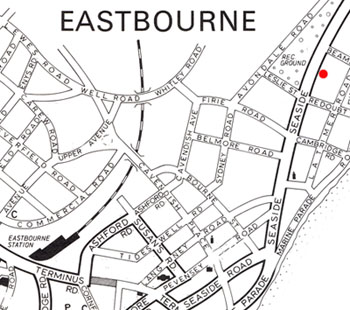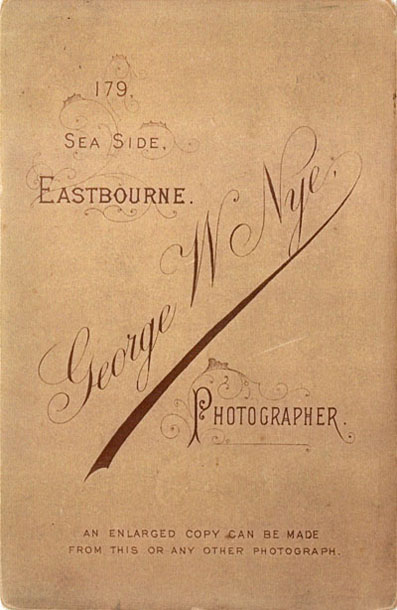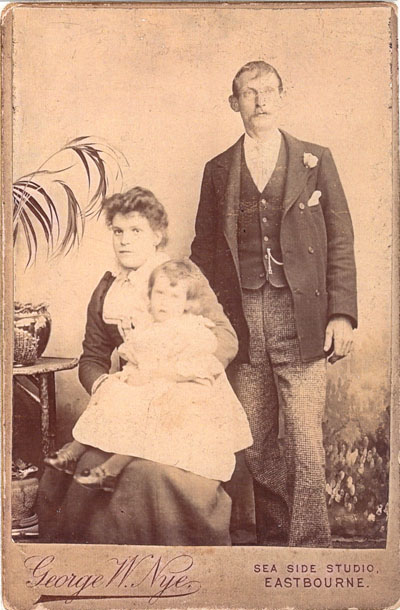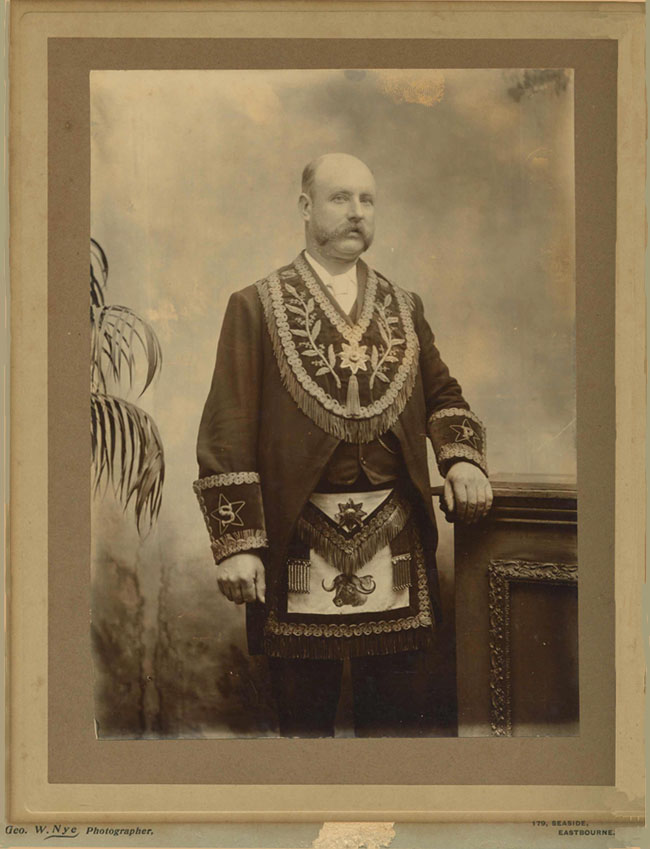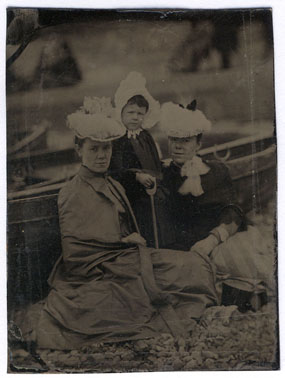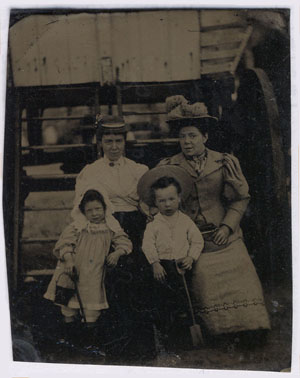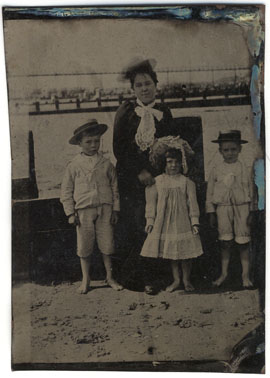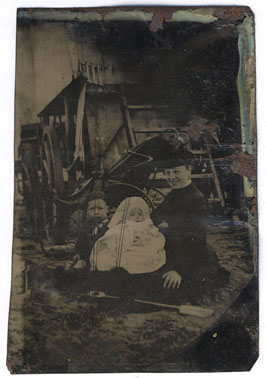Henry Augustus Niblett was born in 1826 within the parish of St Brides, in the Fleet Street area of London. On 16th December 1857, Henry Augustus Niblett married Ellen Assiter (born c1828, Maidstone, Kent) at the Church of St Botolph without Aldersgate, London. At the time of his marriage to Ellen Assiter, Henry Augustus Niblett was working as a "Drapery Traveller". The couple's first child was born on 26th August 1858 in the St Pancras area of London and was christened Mary Ellen Niblett at the Old Church, St Pancras on 21st November 1858. A second child, a son named Henry Assiter Niblett, was born in the Clerkenwell district of London in 1860. Mrs Ellen Niblett gave birth to a third child, a daughter named Emmeline Elizabeth Niblett, in the London district of Pentonville in 1863. [The birth of Emmeline Elizabeth Niblett was registered in the London district of Clerkenwell during the 3rd Quarter of 1863].
In 1865, Henry Augustus Niblett arrived in the Sussex seaside resort of Eastbourne and established a photographic portrait studio at 42 Terminus Place, Eastbourne. Henry Niblett's photography business in Terminus Place went under the name of "The Eastbourne Photographic Establishment". An advertisement for The Eastbourne Photographic Establishment, dated 12th April 1865, described Henry Niblett's photographic studio as "the Largest Gallery in Eastbourne". This claim implied that there were a number of photographic studios operating in Eastbourne in 1865, when, in fact, there was probably only four photographic portrait studios in Eastbourne at that time. The Eastbourne Photographic Establishment's three competitors in the field of portrait photography were Mr. W. Miller's Victoria Photographic Studio at 5 Albert Place, Seaside Road, William Hicks' Original Photographic Studio at 4 Cornfield Road and T. S. Gowland's Photographic Studio at The Library in Eastbourne's Marine Parade.
Henry Augustus Niblett announced the opening of his "Photographic Establishment" in April 1865. An advertisement for The Eastbourne Photographic Establishment, which appeared in The Eastbourne Gazette on12th April 1865, described a wide range of photographic services. In addition to the taking of "First-Class Portraits", Niblett's photographic establishment also offered to make copies of works of art and arrange for a specialist in outdoor photography to take pictures of "Mansions, Estates, Out-door Groups, Cattle, &c.". Henry Niblett also advertised "Local Views of Interest, Stereoscopic Cartes" and "a great variety of Photographic Scraps, from the Old and New Masters" which could be purchased at his premises at 42 Terminus Place, Eastbourne.
It appears that Henry Niblett might have over-stretched himself financially, because on 9th October 1865, just six months after he had opened his Photographic Establishment in Eastbourne, Niblett was declared bankrupt.
Henry Augustus Niblett returned to London, where, in 1866, he opened a photographic portrait studio at 14 Albany Street, close to London's Regent's Park. After only a year, Niblett was forced to close his studio at 14 Albany Street, London. Undeterred, Henry Niblett continued his career as a professional photographer, mainly operating in the Marylebone district of London.
The 1870s were a sad time for Henry Niblett. In 1877, after nearly twenty years of marriage, Henry Niblett's wife Ellen died in Islington, London, at the age of 49. The following year, Henry Niblett's only son Henry Assiter Niblett died before reaching his 18th birthday. [The death of Henry Assiter Niblett was registered in the Kent district of Thanet during the 4th Quarter of 1878].
When the census was taken on 3rd April 1881, Henry A. Niblett and his two daughters, Mary and Emmeline, were recorded at 178 Marylebone Road, London. Although, Henry Niblett was still working as a photographer, he had been obliged to take in three lodgers; two middle-aged spinsters and a twenty year old trainee in the Indian Civil Service. Henry Augustus Niblett was recorded at different addresses in London's Marylebone Road for the next twenty years. In 1891, Henry Augustus Niblett was described as a "photographic art publisher & agent" living at 67 Marylebone Road, London. A decade later, Henry Niblett was recorded as a photographer at 176 Marylebone Road, London.
Henry Augustus Niblett died in Hendon, Middlesex, in 1909, at the age of 83.
|
Acknowledgements |
| I am grateful to the photoLondon website for providing information on the London career of Henry Augustus Niblett in The Database of 19th Century Photographers and Allied Trades in London: 1841-1901. The information in The Database of 19th Century Photographers in London is based on the research of the London photo-historian David Webb. |

| [ABOVE] An advertisement for The Eastbourne Photographic Establishment at 42 Terminus Place, Eastbourne which appeared in The Eastbourne Gazette on 12th April 1865. The proprietor of the Eastbourne Photographic Establishment was Henry Augustus Niblett, a former drapery salesman from London. |

| [ABOVE] A modern map of Eastbourne showing the location of Terminus Place where Henry Niblett opened his Photographic Establishment in 1865. Terminus Place was absorbed by Terminus Road around 1869. |
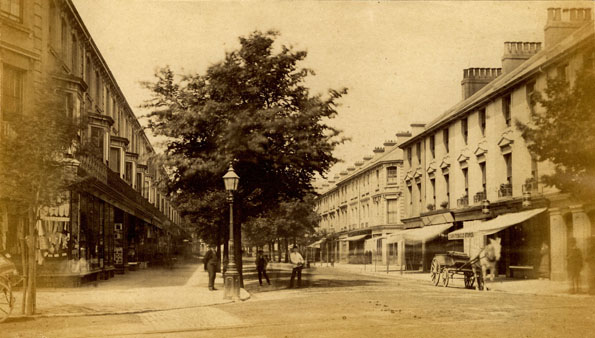
|
[ABOVE] Terminus Road, Eastbourne, photographed in 1881. Henry Niblett's photographic studio was located at 42 Terminus Place, Eastbourne in 1865. Four years after Henry Niblett left Eastbourne, the parade of buildings known as Terminus Place were absorbed by Terminus Road. When the buildings were re-numbered around 1869, "No. 42 Terminus Place" became "No. 71 Terminus Road". |

